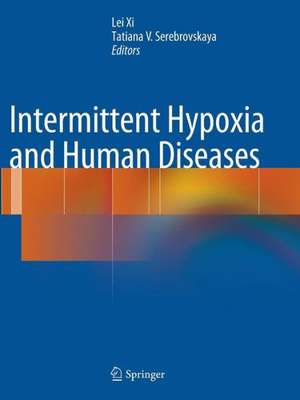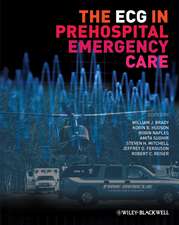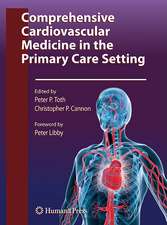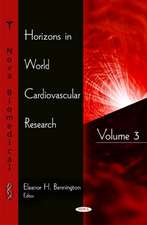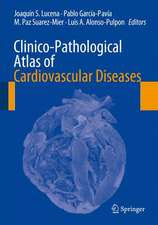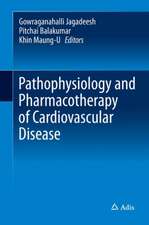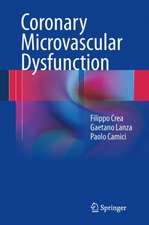Intermittent Hypoxia and Human Diseases
Editat de Lei Xi, Tatiana V. Serebrovskayaen Limba Engleză Paperback – 17 iul 2014
| Toate formatele și edițiile | Preț | Express |
|---|---|---|
| Paperback (1) | 855.07 lei 6-8 săpt. | |
| SPRINGER LONDON – 17 iul 2014 | 855.07 lei 6-8 săpt. | |
| Hardback (1) | 1119.94 lei 38-44 zile | |
| SPRINGER LONDON – 7 iun 2012 | 1119.94 lei 38-44 zile |
Preț: 855.07 lei
Preț vechi: 900.07 lei
-5% Nou
Puncte Express: 1283
Preț estimativ în valută:
163.63€ • 169.87$ • 136.45£
163.63€ • 169.87$ • 136.45£
Carte tipărită la comandă
Livrare economică 22 martie-05 aprilie
Preluare comenzi: 021 569.72.76
Specificații
ISBN-13: 9781447160229
ISBN-10: 1447160223
Pagini: 328
Ilustrații: XII, 316 p.
Dimensiuni: 210 x 279 x 17 mm
Greutate: 0.74 kg
Ediția:2012
Editura: SPRINGER LONDON
Colecția Springer
Locul publicării:London, United Kingdom
ISBN-10: 1447160223
Pagini: 328
Ilustrații: XII, 316 p.
Dimensiuni: 210 x 279 x 17 mm
Greutate: 0.74 kg
Ediția:2012
Editura: SPRINGER LONDON
Colecția Springer
Locul publicării:London, United Kingdom
Public țintă
Professional/practitionerCuprins
1.Sleep Disordered Breathing and Cardiac Arrhythmias.- 2.Effects of Chronic Intermittent Hypoxia on Cardiac Rhythm Transcriptomic Networks.- 3.Intermittent Hypoxia and Atherosclerosis.- 4.Protective Effects of Chronic Intermittent Hypoxia Against Myocardial Ischemia/Reperfusion Injury.- 5.Role of Mitochondrial Permeability Transition Pore in Intermittent Hypoxia-Induced Cardiac and Neuronal Protection.- 6.Intermittent Hypoxia Alters the Function of Cardiovascular Neurons and Reflex Pathways in the Brainstem.- 7.Effect of Intermittent Hypoxia on Breathing Stability in Individuals with Sleep Apnea.- 8.Activation of Inflammatory Circulating Factors by Intermittent Hypoxia in Sleep Apnea Syndrome.- 9.Beneficial Effects of Intermittent Normobaric Hypoxia Training on Respiratory Function in Patients with Chronic Pulmonary Diseases.- 10. Effects of Intermittent Hypoxic Training on Exercise Tolerance in Patients with Chronic Obstructive Pulmonary Disease.- 11.Intermittent Hypoxia inTreatment of Bronchial Asthma in Childhood.- 12.Intermittent Hypoxia and Experimental Parkinson’s Disease.- 13.Protective Effects of Adaptation to Hypoxia in Experimental Alzheimer’s Disease.- 14.Neuroprotective Mechanisms of Intermittent Hypoxia: An In Vitro Study.- 15.Intermittent Hypoxia Training to Enhance Endurance in Elite Swimmers.- 16. Adaptation to Intermittent Hypoxia/Hyperoxia Enhances Efficiency of Exercise Training.- 17.Hypobaric Interval Hypoxia as a Non-Medication Method of Improving the Functional State of Aerospace Pilots and Astronauts.- 18. Intermittent Hypoxia Remedies Male Sub-fertility.- 19.Anticancer Effects of Intermittent Hypoxia in Acute Myeloid Leukemia.- 20.Energotropic Effects of Intermittent Hypoxia: Role of Succinate-Dependent Signaling.- 21.Intermittent Hypoxia and Health: from Evolutionary Aspects to Mitochondrial Rejuvenation.- 22.Benefits and Risks of Different Regimen of Intermittent Hypoxic Training.- 23.Individualized Intermittent Hypoxia Training:Principles and Practices.- 24.Hypoxicators: Review of the Operating Principles and Constructions.- 25.Method of Combined Intermittent Hypoxia and Surface Muscle Electrostimulation for Enhancing Peripheral Stem Cells in Humans.
Intermittent Hypoxia and Atherosclerosis.- 4.Protective Effects of Chronic Intermittent Hypoxia Against Myocardial Ischemia/Reperfusion Injury.- 5.Role of Mitochondrial Permeability Transition Pore in Intermittent Hypoxia-Induced Cardiac and Neuronal Protection.- 6.Intermittent Hypoxia Alters the Function of Cardiovascular Neurons and Reflex Pathways in the Brainstem.- 7.Effect of Intermittent Hypoxia on Breathing Stability in Individuals with Sleep Apnea.- 8.Activation of Inflammatory Circulating Factors by Intermittent Hypoxia in Sleep Apnea Syndrome.- 9.Beneficial Effects of Intermittent Normobaric Hypoxia Training on Respiratory Function in Patients with Chronic Pulmonary Diseases.- 10. Effects of Intermittent Hypoxic Training on Exercise Tolerancein Patients with Chronic Obstructive Pulmonary Disease.- 11.Intermittent Hypoxia in Treatment of Bronchial Asthma in Childhood.- 12.Intermittent Hypoxia and Experimental Parkinson’s Disease.- 13.Protective Effects of Adaptation to Hypoxia in Experimental Alzheimer’s Disease.- 14.Neuroprotective Mechanisms of Intermittent Hypoxia: An In Vitro Study.- 15.Intermittent Hypoxia Training to Enhance Endurance in Elite Swimmers.- 16. Adaptation to Intermittent Hypoxia/Hyperoxia Enhances Efficiency of Exercise Training.- 17.Hypobaric Interval Hypoxia as a Non-Medication Method of Improving the Functional State of Aerospace Pilots and Astronauts.- 18. Intermittent Hypoxia Remedies Male Sub-fertility.- 19.Anticancer Effects of Intermittent Hypoxia in Acute Myeloid Leukemia.- 20.Energotropic Effects of Intermittent Hypoxia: Role of Succinate-Dependent Signaling.- 21.Intermittent Hypoxia and Health: from Evolutionary Aspects to Mitochondrial Rejuvenation.- 22.Benefits and Risks of Different Regimen of Intermittent Hypoxic Training.- 23.Individualized Intermittent Hypoxia Training: Principles and Practices.- 24.Hypoxicators: Review of the Operating Principles and Constructions.- 25.Method of Combined Intermittent Hypoxia and Surface Muscle Electrostimulation for Enhancing Peripheral Stem Cells in Humans.
Intermittent Hypoxia and Atherosclerosis.- 4.Protective Effects of Chronic Intermittent Hypoxia Against Myocardial Ischemia/Reperfusion Injury.- 5.Role of Mitochondrial Permeability Transition Pore in Intermittent Hypoxia-Induced Cardiac and Neuronal Protection.- 6.Intermittent Hypoxia Alters the Function of Cardiovascular Neurons and Reflex Pathways in the Brainstem.- 7.Effect of Intermittent Hypoxia on Breathing Stability in Individuals with Sleep Apnea.- 8.Activation of Inflammatory Circulating Factors by Intermittent Hypoxia in Sleep Apnea Syndrome.- 9.Beneficial Effects of Intermittent Normobaric Hypoxia Training on Respiratory Function in Patients with Chronic Pulmonary Diseases.- 10. Effects of Intermittent Hypoxic Training on Exercise Tolerancein Patients with Chronic Obstructive Pulmonary Disease.- 11.Intermittent Hypoxia in Treatment of Bronchial Asthma in Childhood.- 12.Intermittent Hypoxia and Experimental Parkinson’s Disease.- 13.Protective Effects of Adaptation to Hypoxia in Experimental Alzheimer’s Disease.- 14.Neuroprotective Mechanisms of Intermittent Hypoxia: An In Vitro Study.- 15.Intermittent Hypoxia Training to Enhance Endurance in Elite Swimmers.- 16. Adaptation to Intermittent Hypoxia/Hyperoxia Enhances Efficiency of Exercise Training.- 17.Hypobaric Interval Hypoxia as a Non-Medication Method of Improving the Functional State of Aerospace Pilots and Astronauts.- 18. Intermittent Hypoxia Remedies Male Sub-fertility.- 19.Anticancer Effects of Intermittent Hypoxia in Acute Myeloid Leukemia.- 20.Energotropic Effects of Intermittent Hypoxia: Role of Succinate-Dependent Signaling.- 21.Intermittent Hypoxia and Health: from Evolutionary Aspects to Mitochondrial Rejuvenation.- 22.Benefits and Risks of Different Regimen of Intermittent Hypoxic Training.- 23.Individualized Intermittent Hypoxia Training: Principles and Practices.- 24.Hypoxicators: Review of the Operating Principles and Constructions.- 25.Method of Combined Intermittent Hypoxia and Surface Muscle Electrostimulation for Enhancing Peripheral Stem Cells in Humans.
Textul de pe ultima copertă
The scientific field of intermittent hypoxia and its effects on living organisms is surrounded by divergent and controversial findings. Does the condition play pathogenic roles in disease states, such as sleep apnea, chronic pulmonary disease, cardiovascular disease and cancer? Or does exposure to intermittent hypoxia actually induce protective responses?
Dealing with these long-standing controversies and new concepts, Intermittent Hypoxia and Human Diseases provides an open forum for the most up-to-date scientific understanding of both adaptive (beneficial) and maladaptive (detrimental) responses to intermittent hypoxia and their potential pathogenic and prophylactic roles in the development and progression of major human diseases.
The Editors and their extremely experienced contributors have assembled this highly disease-oriented book and all the fundamental research findings are selectively presented as mechanistic explanations of a particular human disease. It is therefore especially prepared for the interests of clinicians, allied healthcare professionals, athletic trainers, and translational medical researchers.
Dealing with these long-standing controversies and new concepts, Intermittent Hypoxia and Human Diseases provides an open forum for the most up-to-date scientific understanding of both adaptive (beneficial) and maladaptive (detrimental) responses to intermittent hypoxia and their potential pathogenic and prophylactic roles in the development and progression of major human diseases.
The Editors and their extremely experienced contributors have assembled this highly disease-oriented book and all the fundamental research findings are selectively presented as mechanistic explanations of a particular human disease. It is therefore especially prepared for the interests of clinicians, allied healthcare professionals, athletic trainers, and translational medical researchers.
Caracteristici
Across-the-board coverage on intermittent hypoxia research Highly disease-oriented All fundamental research findings presented as the mechanistic explanation of a particular human disease Includes supplementary material: sn.pub/extras Includes supplementary material: sn.pub/extras
